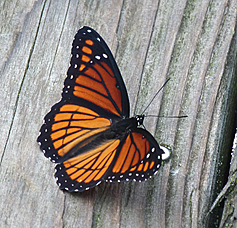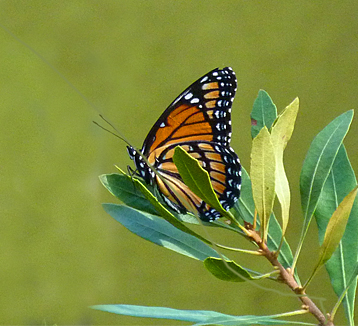

The butterfly in the above image is a Viceroy. It’s sometimes confused with a Monarch butterfly because of its coloration, orange background with black and white markings.
Some key differences in the two are that Viceroys are smaller than Monarchs, have a more rapid wing beat, and the Viceroy has a transverse bar across its rear wings which the Monarch lacks.
The host food of Monarchs is milkweed. Viceroys prefer willows, so your chances of seeing a Viceroy are increased if you visit areas where willows grow, wetlands. Both Monarchs and Viceroys visit a variety of flowers to sip nectar, but hang around a wetland and sooner or later you’ll run into a Viceroy. Monarchs can be scarce in our area except during migration.
And where does the Viceroy get its name? A Viceroy is the governor of a state, province or country ruling as a representative of a king or monarch. Since the smaller Viceroy was at one time (and still is by some) thought to be a mimic of the Monarch butterfly it was given the name Viceroy.
What, if any, is the advantage of having a similar appearance to another butterfly? Well, in the case of the Viceroy and Monarch it has to do with taste. We all know, or should know by now, that Monarchs lay their eggs on milkweed. Milkweed is toxic. When the caterpillars of the Monarch eat the milkweed they also become toxic and so too the butterflies that the caterpillars become. Any bird that chases after and catches a Monarch with hopes of making a meal of it will most likely spit out the foul tasting insect. The next time a big orange butterfly flies into view, the bird will think twice before taking chase.
Like the Monarch, the Viceroy is also a big orange butterfly. And, upon seeing a Viceroy, any bird that has had the displeasure of dining on a Monarch will probably let the similar looking Viceroy flutter right on by, unmolested.
The name for that kind of mimicry, where one apparently harmless species looks similar to a toxic or otherwise dangerous species is called Batesian mimicry. However, it is now believed by many scientists that what is really going on between these two species is unrelated, they both developed their bright “warning” coloration independent of one another and are both toxic, at least to some degree. That type of mimicry is called Mullerian mimicry.

Monarchs will soon be moving south through our area, Viceroys are already among us. Come on out and have a look to see if you can spot one, or both, of these handsome looking lepidopterans.